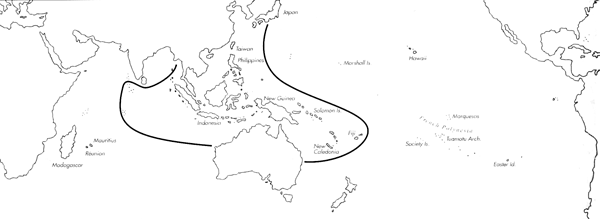
Skip Navigation Links
View access keys for this site.

Range: Indian Ocean: Maldive and Chagos Archipelagoes to W. Australia; Pacific: Japan to Philippines, E. Australia and Fiji.
Description: Moderately large to large, solid to moderately heavy. Last whorl usually conical; outline convex near shoulder, almost straight below. Shoulder angulate, sometimes subangulate. Spire low, outline straight to concave. Larval shell of 3-3.5 whorls, maximum diameter about 0.9 mm. About first 2.25 postnuclear whorls tuberculate. Teleoconch sutural ramps flat, weakly concave in late whorls of some specimens, with 2 increasing to 4-5 weak or strong, often punctate spiral grooves. Last whorl with weak spiral ribs at base; in subadults, ribs strong and followed by rather widely spaced spiral rows of punctations to centre.
| Shell Morphometry | ||
|---|---|---|
| L | 55-107 mm | |
| RW | 0.35-0.80 g/mm | |
| ((L 55-80)) | ||
| RD | 0.56-0.70 | |
| PMD | 0.84-0.91 | |
| RSH | 0.06-0.13 | |
Ground colour white. Last whorl spirally banded with greenish yellow or orange, leaving a ground-colour band at shoulder and centre. Central band edged but rarely crossed by dark brown to black spots and often shaded with tan; subshoulder band crossed by dark brown axial markings. A few spiral rows of coarse dark brown dots may occur on subshoulder area and centrally. Base and basal part of columella violet in juveniles; violet colour sometimes persists to adult stage. Larval whorls and about 3 adjacent sutural ramps white or pale yellow. Later sutural ramps white, with greyish olive to black radial blotches that may extend to subshoulder area. Aperture translucent, becoming opaque and white in large adults.
Periostracum olive to dark brown and thin, becoming thicker during growth, translucent to opaque, with widely spaced spiral rows of tufts on last whorl and tufted axial ridges on sutural ramps; on last whorl, tufts may be restricted to collabral zone.
Animal either very similar to or distinctly different from that of C. capitaneus in colour pattern, where both species occur sympatrically. Foot dark olive, with yellow or black sides; dorsum shaded with black laterally and densely dotted with black at both ends, may grade to olive-brown medially; sole may grade to olive-black medially. Rostrum yellowish grey to olive, often edged with yellow. Tentacles yellow or olive. Siphon olive to black, often edged with yellow and sometimes with a few yellow spots; dorsal side may have densely set black dots centrally and proximally (Pl. 75, Fig. 43) (Chaberman, pers. comm., 1981; Kohn, unpubl. observ.).
Habitat and Habits: Intertidal and shallow subtidal; on reefs, on sand often beneath dead coral rocks, on rock or in holes and crevices. C. mustelinus feeds on eunicid and nereid polychaetes (Cernohorsky, 1964, 1978; Kohn & Nybakken, 1975; Reichelt & Kohn, 1985; Richards, pers. comm., 1989).
Discussion: C. mustelinus resembles C. vexillum, C. capitaneus and C. namocanus. C. vexillum attains larger size, has more spiral grooves (ca. 10) on the late sutural ramps, and lacks spiral rows of dark brown markings in adult last whorl pattern. Axial rows of minute brown dots are consistently present in C. vexillum but rarely seen in C. mustelinus. For distinctions of C. mustelinus from C. capitaneus and C. namocanus see DISCUSSIONS of those species. C. melinus refers to a pattern variant of C. mustelinus with spiral rows of dots on the adapical half of the last whorl. C. zukiae represents C. mustelinus with an unusually dark base.

C. mustelinus range map
This section contains verbatim reproductions of the accounts of 316 species of Conus from the Indo-Pacific region, from Manual of the Living Conidae, by Röckel, Korn and Kohn (1995). They are reproduced with the kind permission of the present publisher, Conchbooks.
All plates and figures referred to in the text are also in Röckel, Korn & Kohn, 1995. Manual of the Living Conidae Vol. 1: Indo-Pacific Region.
The range maps have been modified so that each species account has it own map, rather than one map that showed the ranges of several species in the original work. This was necessary because each species account is on a separate page on the website and not confined to the order of accounts in the book.
Return to framed version (returns to search page)